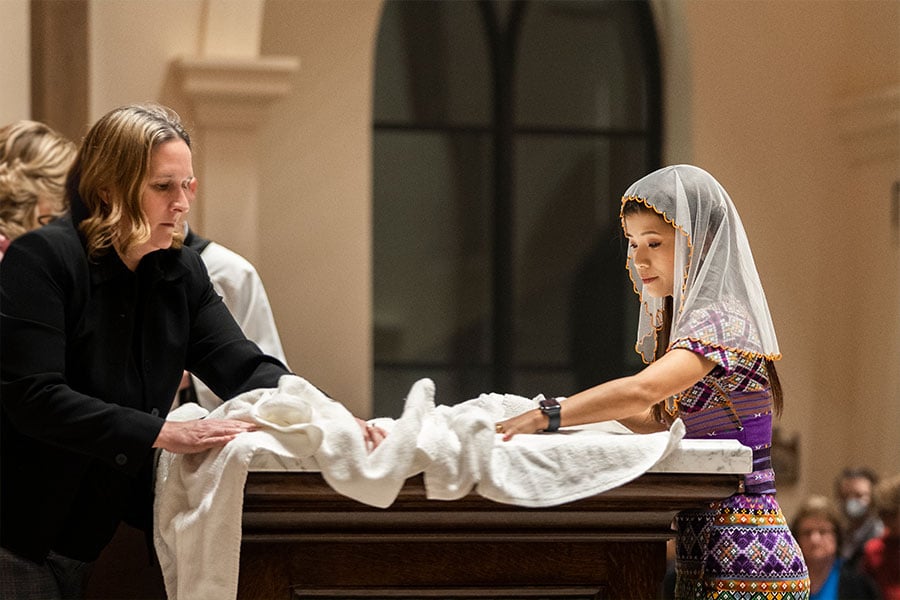Bishop Michael Olson dedicates, consecrates new St. Philip the Apostle church

Bishop Michael Olson blesses the congregation and church building with holy water during the dedication Mass on February 22, 2022. (NTC/Joseph Barringhaus)
FLOWER MOUND — “Surely, the accomplishment we are celebrating tonight is the work of the Lord.”
With those words, Father Ray McDaniel greeted more than 700 parishioners, guests, and clergy who braved frigid temperatures on a wintry February 22 evening to witness Bishop Michael Olson consecrate the building and altar of St. Philip the Apostle Church at its new Flower Mound location. Designed with elements of early English Gothic architecture, the majestic ivory brick and cast stone structure on Cross Timbers Road is the culmination of eight years of planning, fundraising, and construction for the 50-year-old parish.
“Our hearts are full of gratitude. We give thanks to God for His blessing clearly evident in this endeavor,” said Fr. McDaniel, St. Philip’s pastor since 2013.
The new church reflects the beauty of Christ, he noted, adding, “We prayed to Him at meetings, in Masses, at Eucharistic adoration, and, as always, He answered.”
Living a mile from the construction site, Mary Anne Farrell attended the November 3, 2019, groundbreaking ceremony and watched the walls of the building go up. The Dedication Mass was the first time the longtime parishioner saw the church’s interior.

Priests from across the diocese joined more than 700 parishioners during the consecration and dedication of the new St. Philip the Apostle Church on February 22, 2022. (NTC/Juan Guajardo)
“It’s so beautiful. This is a dream come true,” she gushed, looking at the hand-carved crucifix from Germany that hangs over the altar. “The old church [in Lewisville] held a lot of memories and leaving it was sad, but we outgrew it. There were overflow Masses and parking had become a problem.”
Illuminated at night on a hilltop parcel of land, St. Philip’s new church — which seats approximately 900 people — is capturing the attention of nearby homeowners.
“I have neighbors telling me they are going to start going to church here,” Farrell added.
Using the chalice and paten of the Diocese of Fort Worth’s first bishop, John Joseph Cassata, Bishop Olson concelebrated the Mass of Consecration and Dedication with Fr. McDaniel, Monsignor James Hart, Monsignor Francis Tawiah, Father Jonathan Wallis, and more than 40 other priests on the Feast of the Chair of St. Peter.
“Faith has brought us to this building, not simply religious experience,” he told the congregation in his homily. “Faith will transform this building to become a church.”
Like the Apostle Philip, parishioners must be effective messengers in bringing people to Jesus.
“Argument and clever marketing will not conquer indifference. Gimmickry and punditry will not win over the skeptic and the cynic,” he warned.

St. Philip parishioners Ginny Maul and Tha Sung wipe down the newly consecrated altar before dressing it in white linens during the dedication Mass on February 22, 2022. (NTC/Juan Guajardo)
The soon-to-be consecrated church and altar should be a place where the poor find mercy, the oppressed true freedom, and all God’s children are treated with dignity so “many may come and see Christ Jesus.”
Bishop Olson told parishioners they have built only a building.
“It is Jesus Christ the cornerstone, the New and Eternal Covenant who builds His Church through the prayers and acts of consecration of our apostolic ministry,” he explained. “He accomplishes this eternally through the celebration of the Eucharist from which we are sent into the world for His work of salvation. You, the people of God in this parish, with spiritual adoption of the patronal protection of St. Philip the Apostle will do so forward, from now, as a people of faith.”
During the Order of Dedication of a Church and Altar, Bishop Olson intoned the Prayer of Dedication before anointing the altar and walls of the church with Holy Chrism. Rich in spiritual imagery, the prayer dedicates the church to the Lord for all times and asks for His blessing. The use of sacred oil renders the altar a powerful symbol of Christ, the Anointed One, who on the altar of His body, offered His life for the salvation of souls.
Marked with a cross and candle, four walls of the church were anointed with the same chrism signifying the structure is set aside permanently for Christian worship. Fragrant incense was then burned on the altar and carried down the aisles of the church by a deacon as a sign of prayers rising up to God.
Now consecrated as the Lord’s table, the altar was wiped clean by parishioners who then dressed the marble top in white linens before placing flowers against its oak base. The dedication rite concluded with the lighting of candles to remind those present that Christ is the light that dispels darkness in the world.
Situated on 40 acres of a former pasture, the church is only the first phase of a larger expansion project intended to meet the needs of a growing number of Catholics moving into southern Denton County. Plans include increasing the size of the sanctuary as well as adding a parish hall, religious education building, and rectory. A grove of oak trees and surrounding green space provides opportunities for outdoor devotion and the possible installation of Stations of the Cross, according to Fr. McDaniel.
Church members donated more than $9.3 million in a capital campaign to fund construction.
“We have built this house for the Lord. We pray that He may find a home also in our hearts,” the pastor said, addressing parishioners. “This new church has been consecrated tonight for His holy purpose. May He bless and consecrate us anew as we seek to glorify His holy name and spread the Good News of the Gospel to our community and the world.”
